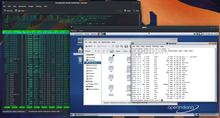| This article possibly contains original research. Please improve it by verifying the claims made and adding inline citations. Statements consisting only of original research should be removed. (November 2023) (Learn how and when to remove this message) |

A screenshot (also known as screen capture or screen grab) is a digital image that shows the contents of a computer display. A screenshot is created by the operating system or software running on the device powering the display.
Screenshot techniques
Digital techniques
The first screenshots were created with the first interactive computers around 1960. Through the 1980s, computer operating systems did not universally have built-in functionality for capturing screenshots. Sometimes text-only screens could be dumped to a text file, but the result would only capture the content of the screen, not the appearance, nor were graphics screens preservable this way. Some systems had a BSAVE command that could be used to capture the area of memory where screen data was stored, but this required access to a BASIC prompt. Systems with composite video output could be connected to a VCR, and entire screencasts preserved this way.
Most screenshots are raster images, but some vector-based GUI environments like Cairo are capable of generating vector screenshots.
Photographic techniques
Screenshot kits were available for standard (film) cameras that included a long antireflective hood to attach between the screen and camera lens, as well as a closeup lens for the camera. Polaroid film was popular for capturing screenshots, because of the instant results and close-focusing capability of Polaroid cameras.
Screenshot tools
See also: Category:Screenshot softwareNotable software for capturing screenshots include:
- Bandicam
- Camtasia
- CamStudio
- CloudApp
- Greenshot
- Gyazo
- IrfanView
- Jing
- KSnapshot
- Lightscreen
- Microsoft Snipping Tool
- Snip and Sketch
- Monosnap
- PrintKey 2000
- Screenpal
- scrot
- ShareX
- Shotty
- Snagit
- Snapz Pro X
- VVCap
- Window Clippings
- Xfire
- XnView
- Xwd
- PicPick
Some web browsers, for example Firefox and Microsoft Edge, have a screenshot tool which can be used to capture a whole web page or part of it.
Common technical issues
Hardware overlays
On Windows systems, screenshots of games and media players sometimes fail, resulting in a blank rectangle. The reason for this is that the graphics are bypassing the normal screen and going to a high-speed graphics processor on the graphics card by using a method called hardware overlay. Generally, there is no way to extract a computed image back out of the graphics card, though software may exist for special cases or specific video cards.
One way these images can be captured is to turn off the hardware overlay. Because many computers have no hardware overlay, most programs are built to work without it, just a little slower. In Windows XP, this is disabled by opening the Display Properties menu, clicking on the "Settings" tab, clicking, "Advanced", "Troubleshoot", and moving the Hardware Acceleration Slider to "None."
Free software media players may also use the overlay but often have a setting to avoid it or have dedicated screenshot functions.
Screen recording
Main article: ScreencastThe screen recording capability of some screen capture programs is a time-saving way to create instructions and presentations, but the resulting files are often large.
A common problem with video recordings is the action jumps, instead of flowing smoothly, due to low frame rate. Though getting faster all the time, ordinary PCs are not yet fast enough to play videos and simultaneously capture them at professional frame rates, i.e. 30 frame/s. For many cases, high frame rates are needed for a pleasant experience.
Copyright issues
Some companies believe the use of screenshots is an infringement of copyright on their program, as it is a derivative work of the widgets and other art created for the software. Regardless of copyright, screenshots may still be legally used under the principle of fair use in the U.S. or fair dealing and similar laws in other countries. Screenshots have also been an object of study in academic research, in fields such as law, media studies, and semiotics.
See also
- Comparison of screencasting software
- Codeless test automation
- Print screen
- Screencast
- Thumbshot
- Video capture
References
- Matthew Allen (November–December 2016). "Representing Computer-Aided Design: Screenshots and the Interactive Computer circa 1960". Perspectives on Science. Retrieved 8 January 2017.
- "RUN Magazine issue 25". January 1986.
- "Details of package gtk-vector-screenshot in stretch". Debian. GitHub
- "macos - Is it possible to take a screenshot in vector format?". Ask Different.
- "Screen Shots (Excluding Xbox)". Use of Microsoft Copyrighted Content. Retrieved 2007-08-22.
- "Use Snipping Tool to capture screenshots". Microsoft. Retrieved 1 September 2021.
- "Question: What are screenshots, and is using them copyright infringement?". FAQ about Copyright -- Chilling Effects Clearinghouse. Retrieved 2007-08-22.
- "Copyright in screenshots? Who owns it?". MetaFilter. Retrieved 2007-08-22.
- "Ask the Law Geek: Is publishing screenshots Fair Use?". Lifehacker. 10 August 2006. Retrieved 2007-08-22.
- Shore Ingber, Alexis (2024-09-18). "Protecting Private Communications through Law and Policy: The Case of the Screenshot Feature". Communication Law and Policy: 1–23. doi:10.1080/10811680.2024.2384356. ISSN 1081-1680.
- Švelch, Jan (2020-09-01). "Redefining screenshots: Toward critical literacy of screen capture practices". Convergence: The International Journal of Research into New Media Technologies. 27 (2): 554–569. doi:10.1177/1354856520950184. ISSN 1354-8565.
- Inwood, Olivia; Zappavigna, Michele (2024-10-06). "The legitimation of screenshots as visual evidence in social media: YouTube videos spreading misinformation and disinformation". Visual Communication. doi:10.1177/14703572241255664. ISSN 1470-3572.